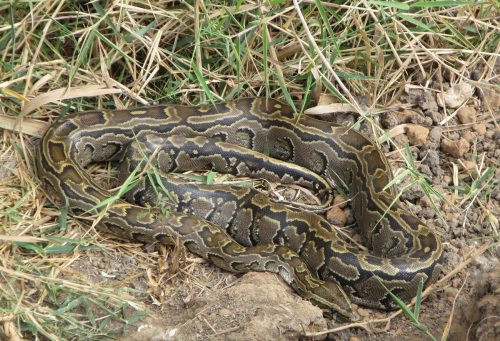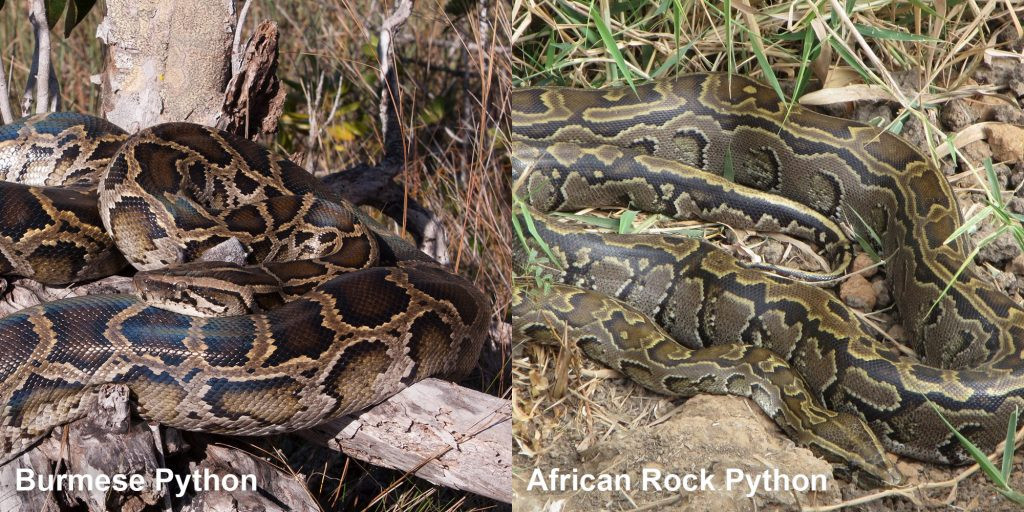African Rock Pythons, also known as Northern African Rock Pythons or African Pythons, are imposing snakes that have established a non-native presence in Florida. While not venomous, their size and powerful bite warrant attention, especially in regions where they are found. This article delves into the key characteristics, habitat, potential risks, and identification of the African Rock Python, providing essential information for residents and wildlife enthusiasts in Florida and beyond.
Identifying the African Rock Python: Size, Appearance, and Key Features
The African Rock Python (Python sebae) is a large and heavily built snake, with adults typically ranging from 10 to 16 feet (3 to 5 meters) in length. Some individuals can exceed this, making them one of the largest snake species globally. Their coloration is a blend of browns and grayish-tans, forming a background for two prominent, irregular dark blotches that run down their back. These blotches are distinctively outlined with black and white, contributing to their camouflage in natural environments.
 African Rock Python coiled in grass, showcasing camouflage pattern
African Rock Python coiled in grass, showcasing camouflage pattern
A key identification mark is the spearhead pattern on the head. The top of the head is dark, contrasted by a light stripe on each side that runs through the eye, converging on the nose to create this spear-like shape. Juvenile African Rock Pythons exhibit similar patterns to adults, but their colors are often more vibrant and sharply defined.
Habitat and Distribution: The Python’s Territory in Florida
Native to sub-Saharan Africa, the African Rock Python is not indigenous to Florida. They are considered a non-native, or exotic, species, with evidence suggesting their establishment in Florida since the early 2000s. While sightings have been reported in counties like Sarasota and Miami-Dade, established populations are currently localized to a small area southeast of US 41 (Tamiami Trail) and SR 997 (Krome Avenue) in Miami-Dade County.
These adaptable snakes have been observed in a variety of habitats within Florida, mirroring their native range’s versatility. They inhabit sawgrass prairies, melaleuca stands, agricultural lands, and even human-modified environments like canals, lakes, and housing developments. This adaptability contributes to their survival and potential spread in non-native environments.
Understanding the Risk: African Rock Pythons and Human Interaction
Despite being non-venomous, African Rock Pythons are powerful animals that can pose risks, particularly due to their size. Their primary defense mechanism is biting. While smaller individuals are not typically considered dangerous to humans or larger pets, adult African Rock Pythons possess large, sharp teeth capable of inflicting severe lacerations.
Large African Rock Pythons are constrictors, meaning they subdue prey by coiling around it and tightening their grip. While documented cases are rare, they are physically capable of preying on domestic animals like dogs and cats. It’s crucial to remember that bites from African Rock Pythons are almost always a result of intentional disturbance or provocation. These snakes are not inherently aggressive and will typically only strike defensively when they feel threatened or cornered.
African Rock Python vs. Burmese Python: Spotting the Differences
In Florida, African Rock Pythons are often compared to Burmese Pythons (Python bivittatus), another large, non-native constrictor snake. Distinguishing between the two is important for identification and reporting purposes.
 Comparison image of Burmese Python and African Rock Python
Comparison image of Burmese Python and African Rock Python
Burmese Pythons have bolder, dark blotches along their backs that are separated by thinner, light-colored bars. Their belly is light in the center with smaller dark spots towards the sides. In contrast, African Rock Pythons have two more continuous and irregular dark blotches down the back, bordered by black and white, and a light-colored belly with a dark mottled pattern. Size-wise, while both are large, the record length for African Rock Pythons in Florida is slightly smaller than that of Burmese Pythons.
Ecology and Behavior: Hunting, Diet, and Reproduction
African Rock Pythons are adept predators, particularly at night, thanks to specialized heat-sensitive pits located between the scales on their upper lips. These pits detect the thermal radiation emitted by warm-blooded prey, enabling them to hunt effectively even in complete darkness.
Their diet in Florida consists of a wide variety of mammals and birds, both wild and domestic, reflecting their opportunistic feeding habits. As powerful constrictors, they can subdue and consume relatively large prey.
Female African Rock Pythons are known to lay a significant number of eggs. In Florida, clutch sizes range from 11 to 47 eggs, but in their native range, they can lay up to 100 eggs. Females exhibit parental care, coiling around their eggs to incubate them until hatching, a period during which they typically do not feed. Hatchlings emerge at a considerable size, measuring between 18 to 24 inches (45-61 cm) in length.
Conservation and Management: Addressing the Non-Native Python Population
Recognizing the potential ecological impact of African Rock Pythons in Florida, efforts are underway to manage and potentially eradicate this species, particularly given their currently limited distribution. However, their cryptic behavior and ability to remain hidden in dense vegetation make detection and removal challenging.
The U.S. Fish and Wildlife Service listed African Rock Pythons as an injurious species in 2012. This designation restricts their importation into the United States, except for specific purposes like research or education with proper permits.
Contributing to Research: Sharing Your Observations
Public participation is valuable in monitoring and understanding the distribution of African Rock Pythons in Florida. If you observe an African Rock Python, consider documenting your sighting. Sharing photos or videos along with location details can contribute to scientific understanding and management efforts. You can report observations to the herpetology staff at the Florida Museum to aid in their ongoing research and database.
Conclusion: Coexisting with Snakes and Staying Informed
While African Rock Pythons are non-venomous, understanding their characteristics and respecting their space is crucial, especially in areas where they are present. By learning to identify them and differentiate them from other species like the Burmese Python, residents and visitors can better coexist with Florida’s diverse reptile fauna. Staying informed and reporting sightings contributes to the ongoing efforts to manage non-native species and maintain the balance of Florida’s ecosystems.
References:
Krysko, K.L., K.M. Enge, and P.E. Moler. 2019. Amphibians and Reptiles of Florida. University of Florida Press, Gainesville, Florida. 706 pp.
Powell, R., R. Conant, and J.T. Collins. 2016. Peterson Field Guide to Reptiles and Amphibians of Eastern and Central North America. Fourth edition. Houghton Mifflin Harcourt Publishing Company, Boston and New York. xiv + 494 pp.
Reed, R.N., K.L. Krysko, R.W. Snow, and G.H. Rodda. 2010. Is the Northern African Python (Python sebae) established in Southern Florida? IRCF Reptiles and Amphibians 17: 52-54.